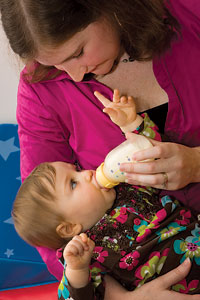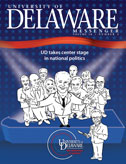Babies' gaze may show early marker for autism


RESEARCH | Most health care professionals agree that early intervention is critical for the nearly one in 100 children now diagnosed with autism spectrum disorder (ASD), a range of complex neurodevelopment disorders characterized by social impairments, communication difficulties and repetitive behavior patterns.
However, early intervention requires early diagnosis, and most children are at least 3 years old before they are diagnosed with the disorder.
Now, a team of researchers that includes Cole Galloway, associate professor of physical therapy, has found what seems to be an early marker for ASD—infrequent gazing at other people when unprompted.
Galloway is co-author of a paper, with Anjana Bhat and Rebecca Landa, reporting the findings of a study carried out at the Kennedy Krieger Institute in Baltimore. Bhat earned her doctorate at UD under Galloway in 2005 and went on to work as a postdoctoral researcher with Landa, director of the Center for Autism and Related Disorders at Kennedy Krieger. The paper was published in The Journal of Child Psychiatry and Psychology.
The study involved 50 6-month-old infants, 25 who have siblings with autism and are therefore considered high risk and 25 from the general population, considered low risk.
In the experimental setup, the infants were seated in a custom chair with an attached joystick within easy reach, a musical toy located to the right and their caregivers on the left. The researchers evaluated how quickly the infants learned that the joystick activated the toy, as well as their level of social engagement with their caregivers.
They found that the babies exhibited similar levels of social gazing when their caregivers actively engaged them by pointing at the toy or expressing excitement. However, the high-risk group spent less time looking to their caregivers and more time fixated on the toy or the joystick when the caregiver did not initiate contact.
This could indicate a disruption in development related to “joint attention,” which is often a core deficit for children with autism, according to the researchers.
“We saw that simple learning was occurring in all of the babies,” Galloway says. “The high-risk infants learned as quickly as their peers that something happened when they pulled the joystick.
“But the fact that these babies looked at Mom only when prompted by her, and not spontaneously, was an important finding with implications for their future social development.… One of the hallmarks of making friends is that you have to initiate contact—kids can’t just sit back and wait for others to approach them. Babies who lack initiation of gaze may not be noticed if the adults in their lives don’t notice.”
Bhat, who did her doctoral work through UD’s interdisciplinary Biomechanics and Movement Science graduate program, says the training she received in Galloway’s lab prepared her for the multi-systems view needed to study problems like autism.
“Everything is related,” she says, “and we have to look at visual, motor, attentional and social development together if we want an accurate picture of what is happening with babies this young.”
The subtle nature of the marker demands that clinicians actually understand the baby, Galloway says, but if the gaze test proves to be an effective diagnostic tool, it opens the door for the early intervention that can make a difference for these children socially.
Article by Diane Kukich , AS ’73, ’84M





